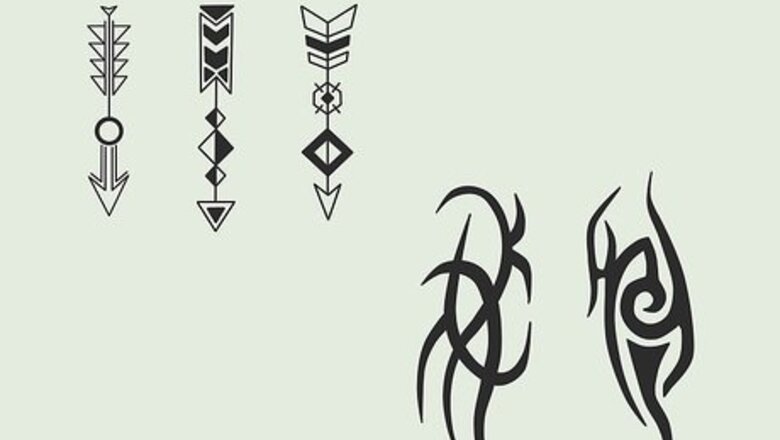
views
Designing a Full Sleeve

Choose a style and stay consistent. Whether you’re getting several realistic portraits or a few simple tribal tattoos, sticking to a single style is essential for designing a sleeve that makes sense as a single piece. Research different styles online and ask to view a tattoo artist’s portfolio to see what kind of styles they specialize in. Once you’ve selected a style, you can begin planning and designing your sleeve. The most popular styles are traditional, realism, watercolor, tribal, new school, neo-traditional, and illustrative. Certain styles work with certain topics or compositions better than others. For example, tribal styles and watercolor are probably not the best for portraits, while abstract or minimalistic styles can work well for these images.
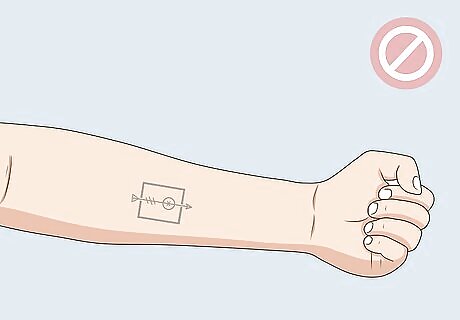
Avoid getting small tattoos as main pieces if they will be hard to connect. If you get a 1–2 in (2.5–5.1 cm) minimalist tattoo in the middle of your forearm, it will disappear in the context of your full sleeve. Avoid running into problems connecting key tattoos by ensuring that each main piece takes up a discernable amount of space on your body. If you’re connecting preexisting pieces, you’re probably going to get smaller tattoos in between the main pieces. These are called filler tattoos. Save your small-tattoo ideas for the filler! Ask a tattoo artist if they think a piece is going to be too small (or too big). Portraits, cartoons, iconic figures, and complex machines are all excellent choices for your larger pieces. If someone were standing 6–8 feet (1.8–2.4 m) away from you, would they be able to tell what your tattoo is? If not, your tattoo may be too small for a main piece on a full sleeve.
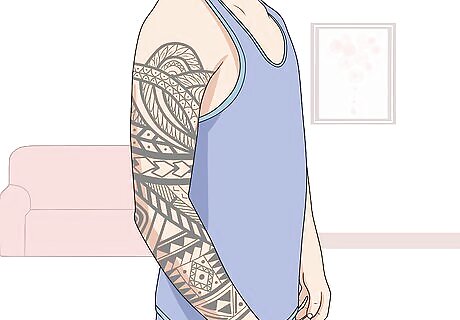
Stick to 1-2 themes to make your sleeve cohesive. If you already have a few nautical tattoos, adding a portrait of a family member will seem odd and out of place. Get tattoos that function together if you’re working on a sleeve by working with a limited number of themes. This will make it easier to connect tattoos in a way that makes sense to others without making your sleeve feel too chaotic or busy. If you’re trying to pay homage to a family member, reference your favorite television program, let people know where you grew up, and show your love for boating all in one sleeve, your tattoos are going to seem disconnected and random. Possible themes include places from your past, loved ones, tribal tattoos, insects, and iconic places from your hometown. Any topic or idea can function as a theme for a sleeve.
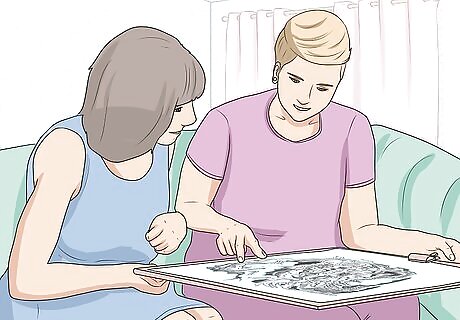
Consult a tattoo artist to start your full sleeve. After you’ve selected an artist and come up with your first design, meet with your tattoo artist before sitting down for your first session. They will be able to advise you on how to work out your first piece and how to add to it. They will also be able to offer some guidance regarding the size, placement, and color choices. Ask to see preliminary sketches before a tattoo artist invests too much time in them. They’ll appreciate saving the energy and you won’t waste any time waiting for a completed sketch to get finished.
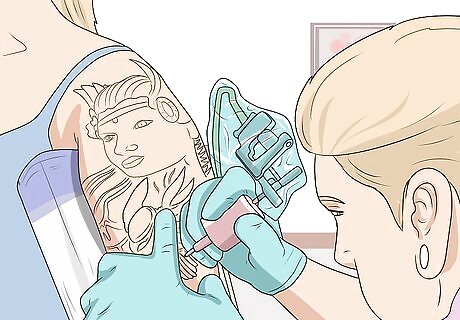
Work with the same tattoo artist to ensure that the work is uniform. Every tattoo artist has a different style and process. Working with the same tattoo artist is a good way to ensure that your sleeve has a consistent style and cohesive feel. This will also make it easier to get your tattoo completed slowly over time, since you won’t need to meet with multiple individual artists to explain your vision and ideas. If possible, avoid tattooing sessions that are longer than 2-3 hours. Not only are they painful, but they make it hard to assess the direction of your sleeve. Ask questions! Solicit advice and feedback from your tattoo artist at every stage of the process in order to make sure that both of you are on the same page. Erick Alayon Erick Alayon, Tattoo Artist Transforming existing tattoos into a cohesive sleeve requires vision and skill. Analyze the current artwork for common themes in style, color palette, and subject first. Then ideate designs that incorporate and link these elements, weaving both background filler and structural main pieces to bridge gaps.
Extending Individual Tattoos Into a Sleeve
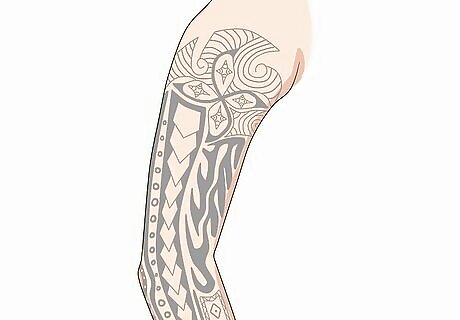
Use the negative space on your skin as contrast if you have a lot of ink. If you already have a lot of colorful or black ink on a sleeve and want to fill in negative space, consider using the empty space on your skin as the interior texture for a tattoo’s outline. Use simple designs, like flowers, clouds, or minimalistic shapes, and leave them unfilled and unshaded to give the impression that the blank skin is working as a part of your design. This is an excellent option if you already have a lot of black ink or shading in your tattoo fills. The contrast between black ink and clear skin can create a strong visual impression. Consider using the empty skin as the background for a silhouette landscape or portrait. The empty skin will make the black figures pop and it will make the empty space feel like a part of the composition. Consult your tattoo artist to see what they would do to fill in the remaining sections of your skin. They’ll have a lot of experience turning smaller pieces into a full sleeve.

Extend images and add on to tattoos to make them bigger. If you already have a few tattoos and have some negative space in between them, add on to them to make them blend into one another more cleanly. Facial portraits can be given necks and shoulders, and flowers can have stems and leaves added on to them. Landscapes can have additional elements added to extend them horizontally or vertically, and minimalistic designs can have geometric lines added to make them larger. Unless your piece is based on a specific individual, you can always add a second version of a piece to fill in nearby spaces. For example, if you have a pair of scissors on your forearm, you can add a switchblade or sewing needle next to it. This will keep the themes intact while adding to the piece. Extended images can be shaded into one another. This is a neat way to connect separate images without detracting from their main elements.
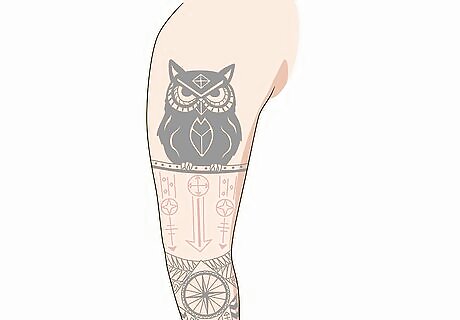
Add some color to black and white tattoos to add some vibrant elements. If you have a lot of tattoos with only black ink, you can connect them by adding some colorful elements to each piece. Red or yellow outlines can easily be added to preexisting tattoos to connect them uniformly. Drips, bubbles, and geometric shapes can all be added to the exterior edges of your main pieces to connect them to one another. If you like the look of all-black tattoos, there’s nothing wrong with keeping your sleeve monochromatic. Color fades over time. Getting color added after you’ve had the black outlines done will ensure that it fades at the same rate and remains uniform.
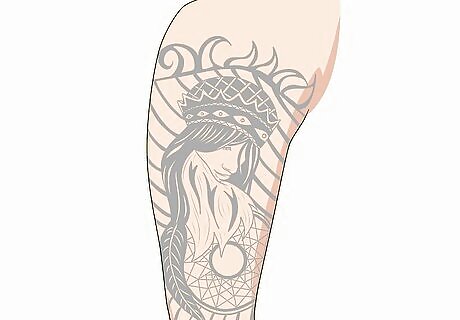
Make filler tattoos lighter and less bold than main pieces. As a general rule, you want filler tattoos to enhance the overall impression of your main pieces, not detract or distract from them. To avoid making a sleeve too busy or overwhelming, always design filler tattoos to be simpler than your main pieces. If you have a lot of black ink, make filler tattoos lighter shades with thinner lines. If you have a lot of color, use more muted shades in your filler pieces. A main piece refers to any tattoo that functions as a cohesive piece of art and covers a larger portion of your skin.
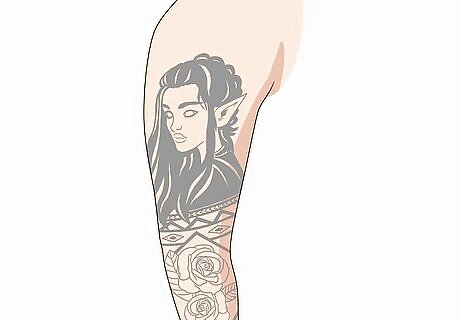
Use simple line work and patterns to fill in un-inked skin. Simple lines and patterns are a good, subtle method to fill in the space between tattoos. Straightforward patterns like parallel lines of varying sizes and stippled textures are excellent choices that can fill in empty space without detracting from your main pieces. Minimalistic line work and patterns work well alongside highly-stylized images and abstract pieces. There are plenty of trippy patterns and illusions that can be added with some simple linework. Wavy checkerboard patterns and geometric shapes can create a crazy effect.
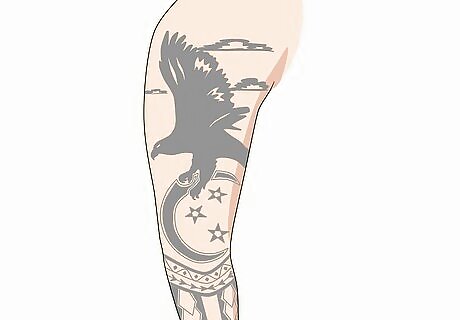
Add some simple images like stars, birds, clouds, or flowers if you want more pieces. If you want to add more visual elements to your sleeve, opt for some simpler compositions that can easily be modified to fit different parts of your skin. For example, you can easily use a few different birds or flowers to fill in different parts of your limb. Landscape elements like trees, clouds, and flowers are great if you have a few nature-themed pieces. This is a good option if you have a lot of traditional, neo-traditional, or new school tattoos. Banners and flags are excellent choices if you want to add some written text but want to give it form or weight in the context of your sleeve.











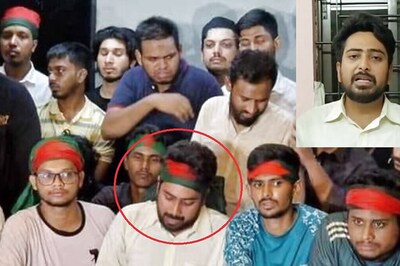







Comments
0 comment